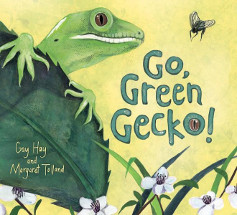Go, green gecko! by Gay Hay

Ill. by Margaret Tolland. Starfish Bay, 2017. ISBN 9781760360337
(Ages: 2-5) Geckos. This is a New Zealand publication and a similar
title, Watch Out, Snail!, is also available. The text, which follows
a repetitive and predictable pattern, is lyrical and has some great
imagery ('Slithering over rotten logs, gulping down a spider') but
it doesn't always flow well ('Scurrying along a riverbank, sneaking
up on dragonflies.'). The refrain ('Watching out for danger, looking
. . . '), however, is great as it encourages young children to join
in the reading and provides a predictable anchor for the reader
which assists in setting a rhythm. The Illustrations are textured
and show the gecko up close as he moves through the long grass,
along branches and over rocks. They are quite good at showing how
the gecko's body bends and moves and young children will enjoy
pointing out the numerous other insects featured in the pages. At
the end of his adventuring the lizard encounters something large and
blue. Scared, he scuttles and scampers back the way he came (shown
through a story map). Then we see the predator (a bird) with a gecko
tail in its mouth and our gecko short of a tail. Confusingly though
the gecko has an intact tail on its return journey. The last two
pages include information about geckos; however, these facts are in
quite big chunks and seem a little dense and lifeless for the target
audience. Some of the information will be interesting to young
children (a gecko's mouth is bright blue inside) while other
inclusions will not be as fascinating (they used to be common in New
Zealand, but now they are not so easy to find). On the title page,
there is a dedication to Ruaumoko, the Maori earthquake god, which
will not be understandable to most Australian children (or adults
for that matter). There are also some other New Zealand specific
references (rata trees). Children who love finding and following
insects in their environment will enjoy following the gecko's
journey but some minor details have been overlooked and overall this
may be more suited to a New Zealand audience.
Nicole Nelson